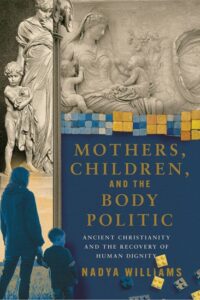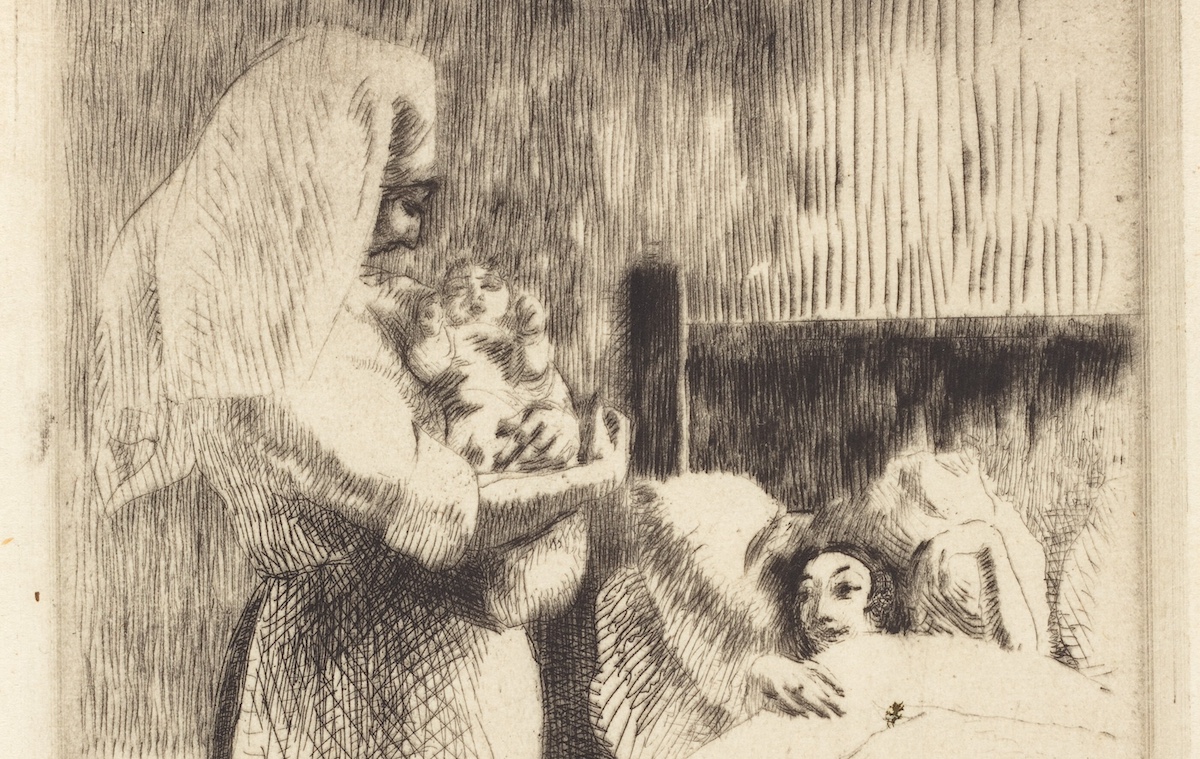Classical Philosophy’s Answer to “Natural Birth”
What is the opposite of “natural?”
The obvious answer is “artificial.” The obvious answer is not the correct one.
The word “artificial” comes from the Latin artificialis/artificium, meaning “handicraft.” It describes that which is made or produced by human beings. The word “art” shares the same etymology.
I recently attended a lecture by Oxford philosopher Dr. Jan Bentz entitled “Objective Beauty in a Subjective World.” Bentz argued in favor of the classical view—held by Plato, Aristotle, and later Aquinas—that art, properly understood, is a continuation of nature, rather than its opposition. Nature, to the ancients, was not the wilderness per se, but God’s imagination: the logos, the inherent order at the heart of the created world. So, Dr. Bentz argues, the opposite of nature is in fact the opposite of logos: it is chaos.
Good art, he went on to say, corresponds to nature by reflecting its material and spiritual reality. Beautiful art must have three components: integritas (wholeness), consonantia (proportion), and claritas (clarity). By these standards, we can judge beauty. Good art is not capricious or random in its execution, as we so often see in modern art galleries. Truly good artists must be trained (brought out of chaos through order) to imitate nature through their chosen media. Furthermore, good artists are made better by interdisciplinary study. The art forms, in the classical worldview, are not discrete mechanisms of autonomous expression. Rather, they are varied modes with a unified purpose: discovering and articulating truth.
Just prior to the lecture, I’d been chatting with my girlfriends about one conflict in the ongoing mommy wars: “natural” birth versus medically assisted birth, which is coded as “unnatural” or artificial. A dear friend has just been through a very difficult experience: an early cesarean section followed by several days in the NICU with her little warrior.
It struck me during the lecture that perhaps the “natural” (home) vs. “unnatural” (hospital) debate is mired in the same false dichotomy as the modern art world. In abandoning the classical definition of nature, the contemporary art world has largely ceased to produce or promote art, properly understood. Having done away with the obligations that a classical view of “nature” and “art” impose on their craft, modern artists instead emphasize non-relational autonomy, prioritizing abstractions over technique and “genius” over training. That’s how we get Pollock over Rembrandt. As a result, the “artists” and the public alike are disconnected from the very notion of beauty.
In a similar way, it seems to me that those on both sides of the false dichotomy between “natural” birth and “artificial” medicine have forgotten the nature of birth and the female body. The naturalists have forgotten the meaning of “nature,” and the medicalists have forgotten their art.
Medicine as Art
We’ll start with the natural birth movement. There’s a reason home birth is growing in popularity, and it isn’t just aesthetic mimesis. Growing skepticism toward the medical community has been earned. I began my own journey as a homebirth mom during 2020, when nurses, doctors, and hospital administrators were behaving in such a way as to inspire distrust, peddling in falsehoods, making care inaccessible and inconvenient, and violating HIPPA routinely under the auspices of an emergency mandate.
In obstetrics specifically, the cause for mistrust goes back further. The standardization of elective abortion—the willful destruction of human life—as care deformed and undermined the art of medicine, whose aim should always be to heal, not to kill. Thanks to the acceptance of hormonal contraception and “gender-affirming care,” those tasked with caring for women’s bodies are instead trained to disable hormonally (or even surgically remove) healthy, fully functioning reproductive systems or organs. For women who know that being asked one’s gender on an intake form at the gynecologist office, or in the obstetrics ward, is not just insulting but indicative of deep and deathly ideological capture, it’s understandably hard to trust the medical providers who work there—let alone relax enough for labor to progress. Advocates of home or free birth often cite the “cascade of interventions,” as well as the administration of medications and procedures with financial gain in mind, as a reason they avoid hospitals. The expansion of medical bureaucracy and depersonalization of care further alienate the patient from her doctor, the doctor from the patient, and both from the real art of medicine.
If we envision medicine as an art form, as it was for Hippocrates, then the practice itself is not “unnatural” but rather a continuation of nature. The original Hippocratic Oath, which dates back to the fourth or fifth century BC, reads, in part:
I will reverence my master who taught me the art…
With regard to healing the sick, I will devise and order for them the best diet, according to my judgment and means; and I will take care that they suffer no hurt or damage. Nor shall any man’s entreaty prevail upon me to administer poison to anyone; neither will I counsel any man to do so. Moreover, I will give no sort of medicine to any pregnant woman, with a view to destroy the child. Further, I will comport myself and use my knowledge in a godly manner. Whatsoever house I may enter, my visit shall be for the convenience and advantage of the patient; and I will willingly refrain from doing any injury or wrong from falsehood.
When medicine is so practiced, as a sacred discipline with reverence for the body and nature, and the determination to restore it to wholeness in proportion to whatever condition it presents with clarity, then it is indeed the art of medicine. It is not only not unnatural, but a beautiful continuation of nature.
The False Allure of Radical Autonomy
One characteristic of being alive is that the body seeks homeostasis. Another characteristic of being alive is being connected to other people; gestation itself reflects human’s deeply communal nature. I want to suggest to the more radical elements of the homebirth world that the act of helping other people stay alive is the most natural part of the human experience.
Neither my daughter Mary Helen nor I are likely to have survived her birth were it not for the medical intervention of my highly skilled midwife. She also managed a severe postpartum hemorrhage with medication. I have remained with the same midwife for four years, delivering two more babies with her help. We plan for my body’s tendency to hemorrhage every time (common for redheads, weirdly). Something random usually complicated my births. My midwife is extremely vigilant and unafraid of sending someone to the hospital if their complications rise to a certain level. She is not ideological about it. Her honesty gives me comfort. Her practice, by the standards I’ve cited, is artful.
At this point, more radically crunchy home birthers and their vanguard, free-birthers, would accuse me of deceit for relying on a form of argumentation they consider a sleight of hand: “If I hadn’t [had some medical procedure], someone would have died.” This is, to many of them, a universally baseless hypothetical designed to provoke fear and shut down debate. According to the freebirth ideology, which is exemplified by Yolande Norris-Clarke, a “freebirth pioneer” who goes by BauhausWife, birth is only imperfect when it is disrupted. Clarke disparages midwives who use the tools of Western medicine as “med-wives.” Far more women are harmed by medical intervention than saved, she says. Midwives cannot serve medicine or women, she says. They must choose one.
Free birth activism strikes me as an expression of radical autonomy cloaked in the language of Gnostic feminism, not all that dissimilar from the radical autonomy that underlies absolute claims for elective abortion (a non-medically necessary intervention). Radical autonomy, in other words, the rejection of discipline in favor of pure instinct, is inherently chaotic. Women are “made for this,” freebirthers say, and from that truism conclude that every woman on earth is completely capable of having a pain-free, orgasmic birth that brings her closer to understanding the mysteries of humanity if she is only sufficiently enlightened and left alone to do so. Ironically, Clarke also compares birth to having a bowel movement.
Indeed, women are “made for birth” in the sense that our physical bodies are ordered toward the distinctively female capacity to bear children. But the long-held Christian doctrine of original sin, unlike the Gnostic-Pelagian ideology that characterizes much of the “natural” birth movement, leaves room for chance, and disaster, too. In destroying the harmony of creation, original sin paved the way for random imperfection and evil due to chance. Bad things happen to good people, even good Christians. It is not a sign of your spiritual inferiority if bad things happen to you, especially during childbirth. The anti-interventionist freebirth movement betrays theology, not just biology, when it suggests the opposite.
The Fetishization of Chaos
As a homebirth mom who made my decision because I felt the hospitals had strayed too far from their mission, I now worry that the purveyors of “natural birth” rhetoric have strayed too far from theirs by neglecting the question of prudence, the possibility of good doctors, and the reality of the dangers of childbirth. The hubristic, radical autonomy implicit to the “free birth” movement, in particular, is not a proper “return to nature.” It is a fetishization of chaos made plausible by the dehumanizing betrayals of modern medicine. Ironically, this glorification of disorder is itself a betrayal of nature, despite its naturalistic, crunchy exterior.
Is there a middle ground? Evie Solheim’s excellent article in The American Conservative outlines some of the challenges that women face when trying to make a decision about where and how to give birth. Personally, I found something that worked for me, helped along by a great deal of divine intervention and personal investigation.
Perhaps the ongoing conflict is necessary to bring to light the shortcomings of both sides. But I fear that the highly politicized battles, one-up-manship, and snide condescension that characterize so much discussion around birth may only encourage partisanship and ideological stubbornness. This does women a disservice. Conceiving of maternal medicine as an art—in which a trusted and well-trained practitioner sees a woman and her child, each in their wholeness, responds in proportion to any complications that may arise, and offers clarity in moments of confusion—might help women confidently make a prudent and wise decision, whatever that may be.



